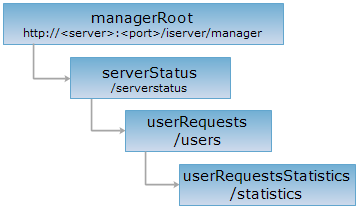
<userRequests uri>/statistics[.<format>]
userRequestsStatistics is the service access resource statistics resource.
Supported Methods:
Supported output formats: rjson, json, html, xml.

Implement the HTTP request on the following URI, where supermapiserver is the server name, with rjson being the output format.
http://supermapiserver:8090/iserver/manager/serverstatus/users/statistics.rjson
Gets the service accessing record number corresponding to users in a certain time.
Implement the GET request on the userRequestsStatistics. The URL can contain the following parameters:
| Name | Type | Description |
| startTime | long | The start time of service access record. If it is not positive number, it will be queried from the earliest record. The value is the milliseconds from 00:00:00 GMT January 1, 1970. |
| endTime | long | The end time of service access record. If it is not positive number, the server time will be the end time. The value is the milliseconds from 00:00:00 GMT January 1, 1970. |
| expectCount | int | The expected returned service record access number. The value is 2000. When expectCount < 0 or expectCount = 0, return all records that meet the condition. |
Perform GET request on userRequestsStatistics reaource http://localhost:8090/iserver/manager/serverstatus/users/statistics.rjson?startTime=1408982476609&endTime=1409104315939&expectCount=2000&statisticsType=UserName. You can get the service access number, and the rjson respondin result is as follows:
{
"admin": 33,
"anonymous": 448
}
Asks for the response identical to the one that would correspond to a GET request, but without the response body. This is useful for retrieving meta-information written in response headers, without having to transport the entire content. The meta-information includes the media-type, content-encoding, transfer-encoding, content-length, etc.
HEAD request can be used to check if the userRequestsStatistics resource exists, or if the userRequestsStatistics resource can be accessed by clients. It can also determine if the userRequestsStatistics resource supports an output format <format> if performed on a URI with .<format> included.